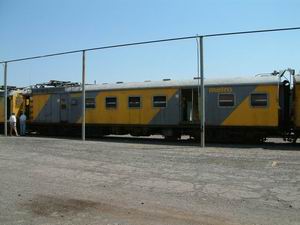

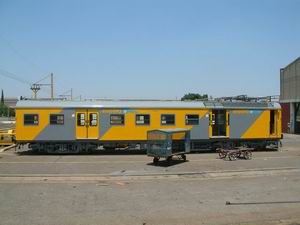

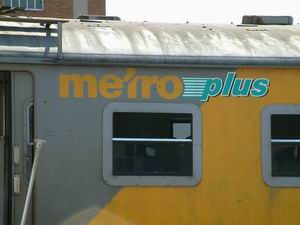

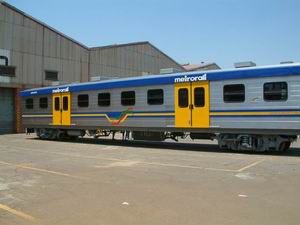
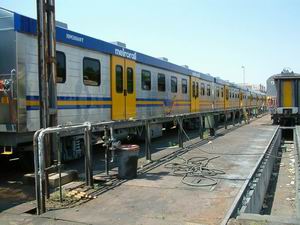




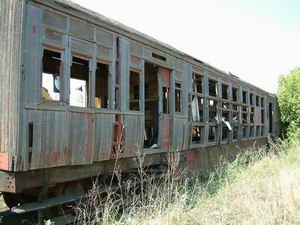


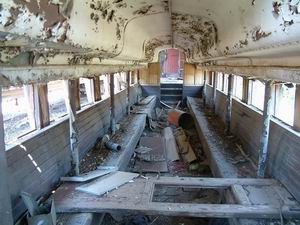
The METRO service has been around in South africa for a very long time. It was not always known as METRO, but names such as Inter Urban service and Commuter service has been used.
I will
try to use this page to show commuter trains as far as possible back, however,
that might not be too far back. Hopefully the bottom of this page
will not turn into a habituary...
 |
This is the current METRO motorcoaches used in Gauteng. It is a 5M. This specific unit is due for a refit and recodition. Photo taken at Koedoespoort, Oct. 2002. |
 |
Here a 3rd class METRO coach that has come in for repairs stands in a long row of similar coaches. Commuters literally tear these things apart, stealing anything from inside panels and handrails to windows and wait for this, the coach doors! An interesting note: notice that the windows are not all the same. This is due to manufacturers changing the appearance of windows ofer time. There are not standard rule how the windows must look, except that they should not open big enough for a person to fit through. This was prompted by commuters getting thrown through train windows in the unrest years in south Africa before the 1994 elections. Picture taken at Koedoespoort, Oct. 2002. |
 |
This is a motorcoach that has basically gone through the whole reconditioning process. Here it stands in its brand new paint job. Notice that the repainted stock has yellow doors, compared to the older stock having grey doors. Incidentally, this is a 1st class motocoach. Picture taken at Koedoespoort, Oct. 2002. |
 |
This is a normal 1st class coach that has gone through the whole reconditioning process. Again the yellow doors being the easiest way to identify the newer rebuilt stock. Picture taken at Koedoespoort, Oct. 2002. |
 |
The way to know the class of a metro is to look at the logo on the side: METRO Plus would be the 1st class stock. Picture taken at Koedoespoort, Oct. 2002. |
 |
This is the logo of a normal 3rd class coach. nly marked as METRO. Picture taken at Koedoespoort, Oct. 2002. |
 |
Here is a side view of the new 10M3 metro stock built for the Cape Town area. The chassis are taken from old 5M units that can not feasabily be rebuilt. The upper parts are stainless steel, inside and out. These coaches are equipped with airconditioning as standard. Picture taken at koedoespoort, Oct 2002. |
 |
The workshops at Koedoespoort have already produced a large number of 10M3 coaches, but only 2 have at the time of this picture (Oct 2002) been moved to Cape Town. The reason being that there might be some modifications that is needed before the coaches will be accepted. Picture taken at Koedoespoort, Oct 2002. |
 |
As can be seen from this photo, the inside of the coaches are very good looking. How long will it stay this way? That is anybody's guess. The benches are made of a very tough plastic, and all the metal inside is stanless steel, with sunken screw heads. At least it should take a little while before we see shacks and informal settlements with metro airconditioning and flourecent lights... Picture taken at Koedoespoort, Oct 2002. |
 |
Before the hype of the Gautrain (or Sholowa Express as it is also jokingly referred to) Spoornet had a go at a 'high speed' inter city train between the cities of Pretoria and Johannesburg. Here are just one of a whole rake of empty shells of what once was the 'METRO BLITZ'. Picture taken at Koedoespoort, Oct 2002. |
 |
A rake of 5 of the old 'METRO BLITZ' coaches standing at Koedoespoort. Who knows what will happen to them? Picture taken at Koedoespoort, Oct 2002. |
 |
For many, the following sequence is a sad sight. This is a one-of-a-kind (for South Africa) dubble decker passenger coach, designed by Oscar Hulse. This coach saw service in Cape Town, Port Elisabeth, and Durban. but was not a very popular design. Picture taken at Koedoespoort, Oct 2002. |
 |
Worse for the wear, this unique coach, is left unprotected, and its condition is deteriorating. Compare these pictures with what Leon Croucamp found in 1999. At least there are not any trees growing through the floor, as has been the fate of some SAR stock stored at other sites in South Africa. Picture taken at Koedoespoort, Oct 2002. |
 |
A sad sight, standing in the entrance looking down at the lower level. Picture taken at Koedoespoort, Oct 2002. |
 |
Not looking any better than the lower level. The upper level roof is almost completely stripped, only the outer wood layer still remaining. Picture taken at Koedoespoort, Oct 2002. |
 |
Standing on the stairs leading to the lower level, one can see all sorts of rubble, including bits broken off the coach laying around. That is one of the doors laying across the 2 rows of seats. Picture taken at Koedoespoort, Oct 2002. |
All pages
on this web site, including the complete page hierarchy and all photos,
copyright Francois Kritzinger, 2003, unless otherwise stated.
No images
may be used without permission